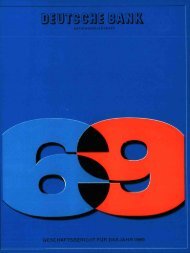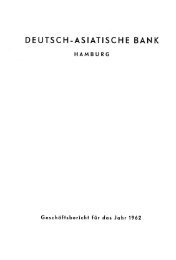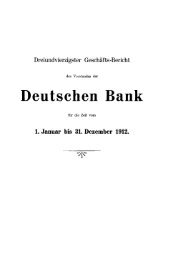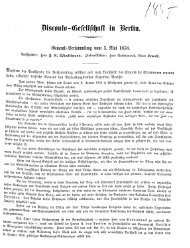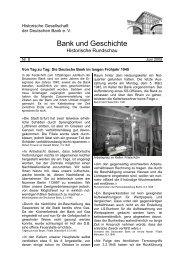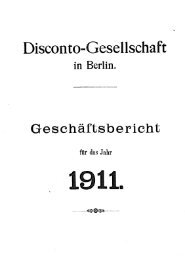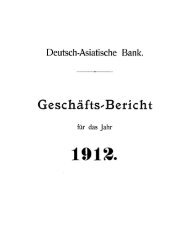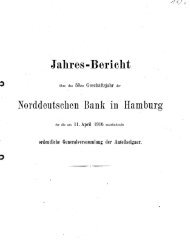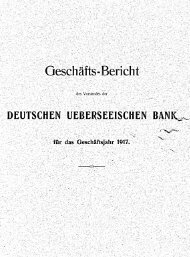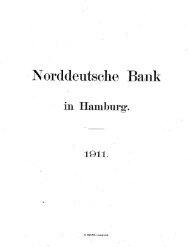Deutsche Bank AG - Historische Gesellschaft der Deutschen Bank e.V.
Deutsche Bank AG - Historische Gesellschaft der Deutschen Bank e.V.
Deutsche Bank AG - Historische Gesellschaft der Deutschen Bank e.V.
You also want an ePaper? Increase the reach of your titles
YUMPU automatically turns print PDFs into web optimized ePapers that Google loves.
Contemporary Art at <strong>Deutsche</strong> <strong>Bank</strong><br />
The Concept<br />
Contemporary art at the bank gives staff, custo-<br />
mers and visitors an opportunity to experience art at<br />
the workplace and encourages them to think about<br />
its conlent 2nd form. This is why <strong>Deutsche</strong> <strong>Bank</strong> pur-<br />
chases mo<strong>der</strong>n art to be displayed at its premises.<br />
Most of the works selected are by artists and sculp-<br />
tors from German-speaking countries, mainly young<br />
artists born in the 1950s and '60s.<br />
In the towers of <strong>Deutsche</strong> <strong>Bank</strong>'s Central Office in<br />
Frankfurt, 1,900 works on paper by 125 artists adorn<br />
the corridors and conference rooms. Further works of<br />
contemporary art can be Seen at many domestic and<br />
foreign branches and subsidiaries.<br />
The bank's artistic concept also includes the de-<br />
sign of its Annual Reports, each featuring the work of<br />
one particular artist. This year, the report contains art<br />
by Horst Antes selected from works in the bank's<br />
collection. Starting at the General Meeting, an exhibi-<br />
tion of Antes' printed graphics will be on display at 30<br />
branches.<br />
Horst Antes<br />
Horst Antes was born in Heppenheim on the Berg-<br />
Strasse in 1936. From 1957 until 1959 he studied<br />
un<strong>der</strong> HAP Grieshaber at the Staatliche Akademie<br />
<strong>der</strong> Bildenden Künste in Karlsruhe. He was lecturer<br />
there from 1965 until 1967, and subsequently profes-<br />
sor until 1973. From 1967 to 1968 he taught asvisiting<br />
professor at the Staatliche Hochschule für Bildende<br />
Künste Berlin. Antes has been professor in Karlsruhe<br />
agüin since 1984.The artist'sfirst individual exhibition<br />
was held in 1960 at the Cologne art gallery "Der Spie-<br />
gel". Today, his art includes not only paintings 2nd<br />
drawings, but also metal sculptures and numerous<br />
graphic works. In the early '60s Antes developed a<br />
process combining the advantages of offset printing<br />
with the creative scope of the lithograph. Since he<br />
spent a period at the Villa Romana in Florence in 1962<br />
he has also devoted himself to the technique of etch-<br />
ing. In 1989 the Sprengel Museum in Hanover<br />
showed a selection of Horst Antes' printed graphic<br />
works.<br />
The artist's early works link the gestural painting of<br />
I'art informel with the figurative style of his teacher<br />
Grieshaber. The "Kopffüssler" (a human figure shown<br />
upside down) that will dominate his works for many<br />
years appears for the first time in 1960. In the<br />
mid-sixties it is often reduced to just the head. "I load<br />
and unload my figure symbolically, sentimentally, or-<br />
ganically, historically", says Antes in describing the<br />
motif, "and fiII it and empty it with allusions, gestures,<br />
thoughts, speculations, wishes and anxieties. I make<br />
myself a picture, I make someone as an image, part-<br />
ner, mirror." The figures are often accompanied by a<br />
bird, rabbit or snake. And sometimes they are shown<br />
in interiors along with objects, such as a large pipe, a<br />
lad<strong>der</strong> or feathers. These motifs can be traced back<br />
to Antes' deep interest in the culture of the Hopi In-<br />
dians in North America.<br />
In 1982 Antes' manner of presentation changes, in-<br />
fluenced by the Falklands war. The human figure is<br />
now outlined with the help of a stencil. Later, the thin<br />
gold foil sculptures, the "Votive", develop out of these<br />
stencils.<br />
1987 marks the beginning of theseriesof "Berliner<br />
Bil<strong>der</strong>", using only the colours black, grey and blue.<br />
The "house of the Navajo", which Antes discovered in<br />
the Canyon de Chelly on a trip to the U.S.A., is a fre-<br />
quent motif.<br />
Horst Antes lives in Karlsruhe, Berlin and Tuscany.



